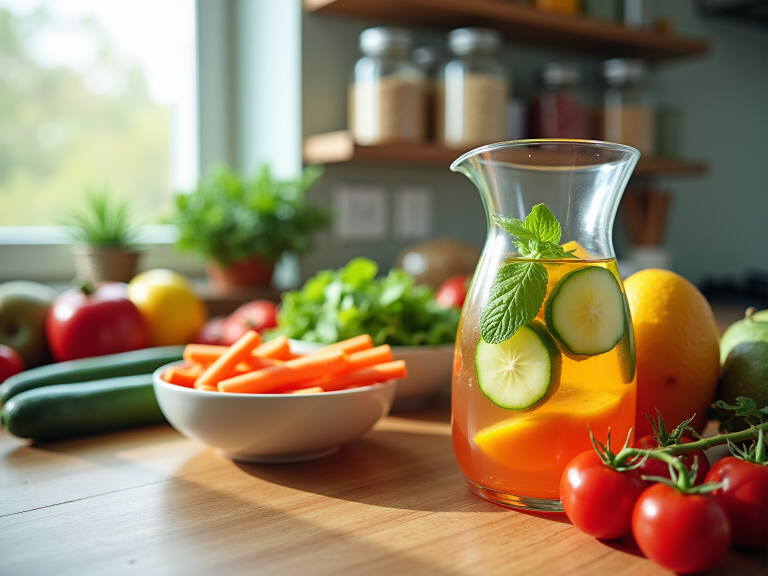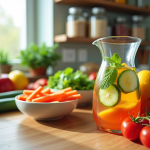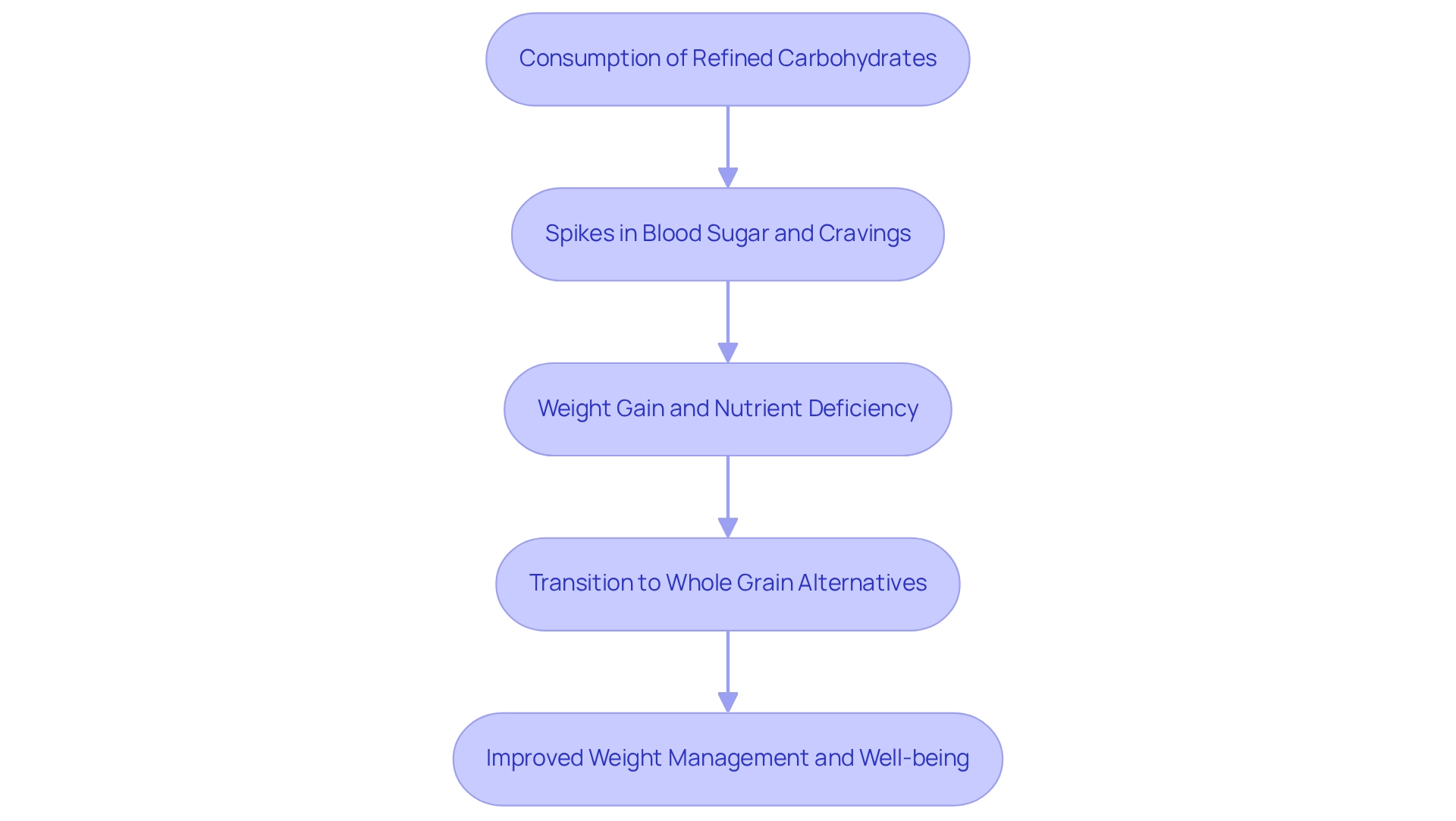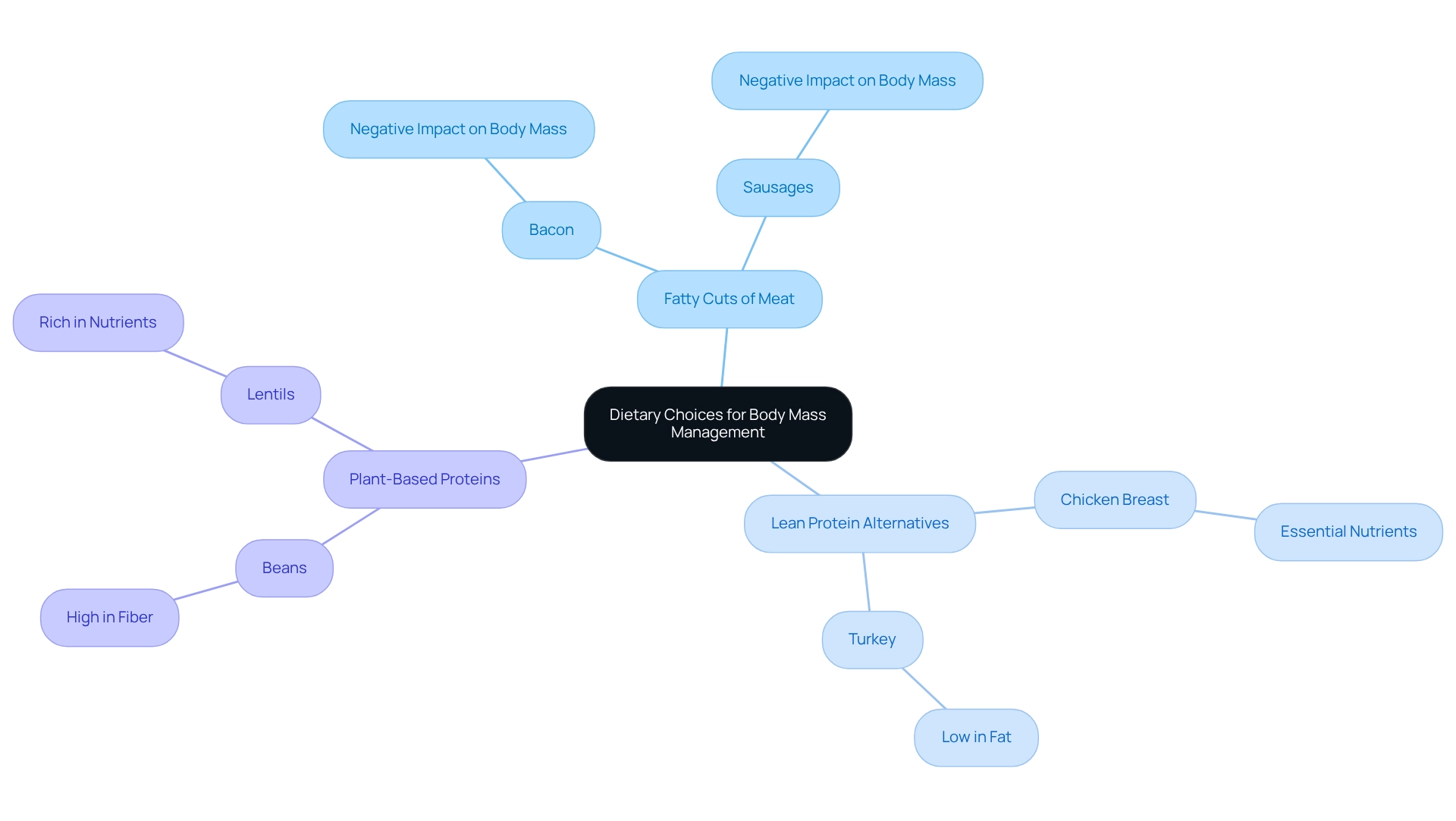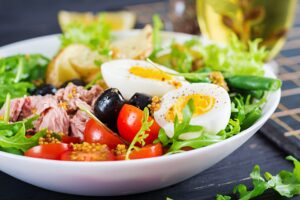Overview
If you’re on a weight loss journey, it’s important to be mindful of certain foods that can hinder your progress.
- Sugary beverages
- High-calorie snacks
- Processed foods
- Refined carbohydrates
- Fatty cuts of meat
- High-calorie desserts
- Full-fat dairy
- Sugary condiments
- Alcohol
- High-sodium foods
These items can lead to increased caloric intake and cravings, making it challenging to manage your body mass effectively, especially if you’re using weight loss medications like semaglutide.
We understand that navigating these choices can feel overwhelming. It’s not just about what to avoid, but also about finding healthier alternatives that support your goals. Together, we can achieve your health aspirations by focusing on nourishing foods that fuel your body and promote well-being. Remember, you are not alone in this journey; we’re here for you every step of the way.
Introduction
In a world that is becoming increasingly aware of the importance of nutrition, the choices we make at mealtime can deeply influence our weight loss efforts and overall health. Have you ever found yourself reaching for a sugary beverage or a high-calorie snack late at night? Understanding the impact of these food choices is crucial for anyone striving to shed pounds or maintain a healthy lifestyle.
This article explores the common pitfalls of modern eating habits, shining a light on the detrimental effects of:
- Sugary drinks
- Processed foods
- Refined carbohydrates
- More
By offering practical alternatives and expert insights, we aim to equip you with the knowledge needed to make healthier decisions. Together, we can pave the way for sustainable weight loss and improved well-being.
Sugary Beverages: Limit Soda and Fruit Juices
Sugary beverages, like sodas and fruit juices, are well-known for their high calorie content and limited nutritional value. Did you know that Americans derive 52% of their calories from sugar-sweetened beverages (SSBs) at home? The remaining 48% are consumed away from home. This prevalent consumption is linked to significant increases in body mass, as highlighted by a systematic review that found a consistent positive association between SSB intake and mass gain, despite variations in study designs.
Notably, Malik et al.’s meta-analysis provides strong evidence supporting measures aimed at reducing SSB intake, further emphasizing the need for caution. Nutrition experts express deep concern about the detrimental effects of these drinks on health. For instance, consuming glp-1 foods to avoid, such as soda and fruit juices, can lead to rapid spikes in blood sugar levels, triggering increased hunger and cravings.
This cycle can make it challenging for individuals to manage their body mass effectively, especially for those on medications like semaglutide aimed at reducing mass. It’s essential for them to be aware of glp-1 foods to avoid. The systematic review also noted the diversity in studies, which may influence the validity of the summary estimates concerning SSB consumption and mass increase, yet a consistent positive correlation was observed.
To support your management objectives, especially when utilizing Minimal’s personalized slimming solutions, consider replacing sugary beverages with healthier alternatives. Water, herbal teas, and sparkling water with a splash of lemon are excellent choices that provide hydration without the added calories. By making these simple substitutions, you can significantly enhance your chances of achieving sustainable body reduction and overall health.
For a practical suggestion, why not arrange a meeting with Minimal’s dietitian? Together, you can explore personalized drink options that align with your journey toward reducing body mass. Keeping a water bottle handy can also encourage hydration throughout the day, making it easier to avoid sugary beverages. Remember, we’re here for you, and together, we can achieve your goals.
High-Calorie Snacks: Avoid Chips and Cookies
High-calorie snacks, especially chips and cookies, can be challenging when it comes to your weight loss journey. These glp-1 foods to avoid are often low in essential nutrients and high in unhealthy fats and sugars, which can lead to increased caloric intake. Have you noticed that almost 30% of people admit to having one or more snack meals after 9 PM? This habit can hinder your progress toward health objectives, contributing to an increase in body mass.
Late-night snacking presents a unique challenge, particularly for those aiming to lose weight. It often results in excessive calorie intake when our bodies are less active. It’s important to recognize this pattern and consider how it affects your goals.
A study titled ‘Impact of Snacking on Obesity in Adults’ highlights the link between snacking habits and body mass. It shows that glp-1 foods to avoid, like energy-dense snacks, are associated with higher energy consumption and greater body mass. This underscores the need for more structured research to clarify how snacking behaviors impact body status. It also emphasizes the importance of social education to promote healthier choices. For those of you looking to shed pounds, understanding these dynamics is crucial in making informed dietary decisions, especially when combined with the personalized nutrition advice offered by Minimal.
To help manage your body composition, consider replacing high-calorie snacks with healthier options. Fresh fruits, vegetables with hummus, or a small handful of nuts can satisfy your cravings without derailing your dietary goals. Dietitians stress the importance of these substitutions, pointing out that healthier snacks not only provide essential nutrients but also help maintain your energy levels throughout the day.
As dietitian Jane Doe wisely states, “Selecting nutrient-rich snacks can create a considerable impact on your journey to reduce body mass.”
In 2025, focusing on healthier snacking is more important than ever. Many individuals are seeking effective ways to reduce their body mass. Current trends indicate a growing awareness of how snacking affects overall well-being. It’s essential for those pursuing a slimmer figure to steer clear of glp-1 foods to avoid and choose nutritious options. By making these choices, you can enhance your chances of success and achieve sustainable health transformations, supported by the holistic approach of Minimal. Together, we can achieve your goals!
Processed Foods: Skip Ready-Made Meals
Prepackaged meals may offer convenience, but they often contain glp-1 foods to avoid that can hinder your weight loss efforts. Many of these meals are high in sodium and saturated fats, which can lead to overeating and slow your progress. A recent analysis of popular ready-meal types revealed that a significant portion did not meet healthy nutritional standards, with many containing excessive levels of fat and sodium.
Notably, chilled products had the lowest median sodium content, highlighting the variability in nutritional quality among ready-made options. This underscores the importance of being informed about what you’re eating.
Research indicates that glp-1 foods to avoid, particularly processed foods and ready-made meals, can negatively impact your weight loss success. The high sodium content in these meals not only contributes to water retention but also increases cravings, making it harder to maintain a calorie deficit. In fact, studies show that individuals consuming processed foods are more likely to struggle with obesity, which emphasizes the need for healthier meal options.
At Minimal, we understand the nutritional drawbacks of these meals. Health professionals caution that relying on ready-made options can lead to poor dietary choices, including glp-1 foods to avoid, as they often lack essential nutrients and fiber that whole foods provide. Dr. Chance Miller notes, “Clients appreciate the personalized attention from a dedicated care team, which includes physicians like me, who emphasize transformative care.” Instead, focusing on dishes prepared with whole ingredients can enhance satiety and nutritional value, helping you feel fuller for longer.
Statistics indicate that processed food intake remains common in dieting practices, and many people may be unaware of the hidden risks. As of 2025, public health initiatives are increasingly advocating for better labeling and consumer awareness to promote healthier ready-made meal options. By prioritizing whole foods over processed alternatives and being mindful of glp-1 foods to avoid, you can significantly improve your chances of achieving sustainable results while using medications like semaglutide.
At Minimal, we’re here for you with a comprehensive approach to weight loss that includes personalized fitness training and nutrition advice, enabling you to make healthier choices. Explore our services to discover how we can support your journey towards sustainable health improvements together.
Refined Carbohydrates: Eliminate White Bread and Pasta
Refined carbohydrates, especially white bread and pasta, often lack essential nutrients and fiber, which can leave you feeling hungrier and may contribute to weight gain. These foods are quickly digested, leading to spikes in blood sugar that can trigger cravings and overeating. Research indicates that diets high in processed carbohydrates—considered glp-1 foods to avoid—are linked to rising obesity rates, as many struggle to manage their weight effectively.
As we move into 2025, the conversation around processed carbohydrates has gained momentum. Nutrition specialists are increasingly advocating for the removal of these items from fat loss strategies. Whole grain alternatives, like whole wheat bread and brown rice, are highly recommended due to their higher fiber content, which promotes a feeling of fullness and supports digestion. Many clients at Minimal have seen remarkable results—losing up to 20% of their body weight—by eliminating refined carbohydrates and embracing these healthier choices.
Experts emphasize the importance of regular nutritional assessments to help individuals manage their refined carbohydrate intake. These assessments empower clients to make informed dietary choices that enhance their body management. Whole grains not only provide vital nutrients but also help stabilize blood sugar levels, reducing the likelihood of weight gain.
Meanwhile, the consumption of processed carbohydrates continues to rise, contributing to obesity and related health issues. Case studies reveal that individuals who swap refined carbohydrates for whole grains report greater satisfaction and improved weight management. For example, one client at Minimal who transitioned from white bread to whole grain alternatives noticed a significant decrease in cravings and an increase in energy levels, leading to a more consistent reduction in body mass.
This shift not only aids in weight loss but also enhances overall well-being. It’s crucial to recognize that avoiding glp-1 foods, like white bread and pasta, is a vital step for those seeking effective weight loss solutions. By choosing whole grain alternatives, you can cultivate a more balanced diet that supports your health goals. Remember, we’re here for you—together, we can achieve your goals.
Fatty Cuts of Meat: Avoid Bacon and Sausages
Fatty cuts of meat, like bacon and sausages, can be tempting due to their flavor, but they fall into the category of GLP-1 foods to avoid. These options are often packed with unhealthy fats and excessive calories that can hinder your efforts to reduce body mass. It’s important to recognize that research suggests these processed meats can negatively impact body mass management, making it essential to reconsider their role in your diet. Instead, why not choose lean protein sources like chicken breast or turkey? These alternatives provide essential nutrients without the added fat.
Incorporating plant-based proteins, such as beans and lentils, can also be a wonderful option for those looking for healthier meal choices. Dietitians emphasize that selecting lean proteins not only helps in shedding pounds but also promotes overall well-being. As Rania Batayneh wisely notes, “Taking a cue from your body and using that as your mindful trigger will be a boon as you continue on your weight-loss journey.”
Moreover, many clients have successfully reduced their body mass by up to 20%, based on insights from over 70,000 patients who engaged for at least six months. This highlights the effectiveness of dietary adjustments, especially when combined with semaglutide and GLP-1 treatments. By implementing these dietary changes, you can enhance your fat loss journey while using these medications, aligning with the holistic approach advocated by wellness experts. Transitioning to healthier meat choices is crucial for sustainable body management and can significantly improve results for those committed to their wellness goals.
Furthermore, discipline in dietary selections is vital. Case studies show that while motivation is important, it is discipline that enables individuals to consistently pursue their wellness objectives. To further support your journey toward a healthier body, consider exploring Minimal’s personalized solutions and holistic health treatments. These resources can offer tailored guidance and assistance as you navigate these dietary changes. Remember, we’re here for you, and together, we can achieve your goals.
High-Calorie Desserts: Steer Clear of Cakes and Ice Cream
High-Calorie Desserts: Avoid Cakes and Ice Cream
Cakes and ice cream, while undeniably tempting, can significantly hinder your weight loss efforts due to their high sugar and fat content. These high-calorie desserts contribute to the obesity epidemic, which currently affects one-third of American adults. Have you noticed how indulging in these treats can lead to increased cravings for sweets? This makes it even more challenging to maintain a balanced diet.
As you reduce your total sugar intake, you might find that foods you once enjoyed taste excessively sweet. This emphasizes the importance of lowering sugar consumption for effective body mass management.
At Minimal, we understand the challenges of making dietary choices while on prescriptions for weight loss, including the need to be mindful of glp-1 foods to avoid, such as Semaglutide. Our holistic approach combines expert guidance, including dietitian consultations and personalized nutrition plans, to empower you to make informed decisions. To satisfy your sweet tooth without derailing your progress, consider healthier dessert alternatives.
Options like fruit salad, yogurt topped with berries, or a small piece of dark chocolate can provide the sweetness you crave while being lower in calories and sugar. Nutritionists highlight that these alternatives not only help curb cravings but also support overall health. For instance, fruit is rich in vitamins and fiber, making it a far better choice than traditional desserts.
In 2021, data from the National Survey of Children’s Health revealed that 57.1% of children aged 1 to 5 had consumed at least one sugar-sweetened beverage in the past week. This underscores the prevalence of sugary foods in our diets.
By selecting healthier dessert options, you can embark on a more sustainable journey towards a healthier body while avoiding glp-1 foods that present challenges due to their high-calorie nature. Moreover, societal initiatives like sugar-sweetened beverage taxation and nutritious food procurement by public entities aim to encourage healthier consumption patterns, further supporting your health objectives.
Understanding the values associated with food purchasing is essential when facing the challenges of high-calorie desserts. By acknowledging these factors, you can make more informed decisions that align with your journey toward reducing size. As you navigate your path, remember that making thoughtful choices about dessert can lead to lasting success.
For a quick reference, here are some healthier dessert options to consider:
- Fruit salad
- Yogurt with berries
- Dark chocolate
- Homemade smoothies
These choices can help satisfy your cravings while keeping your goals for reducing body mass on track, supported by the comprehensive care offered at Minimal.
Full-Fat Dairy: Limit Cream and Whole Milk
While dairy can be a helpful part of a balanced diet, it’s important to recognize that full-fat choices like cream and whole milk are particularly calorie-rich. This can make it more challenging for those striving to reduce body mass. Research has shown that participants in studies focused on high-dairy diets experienced significant reductions in body mass, averaging:
- 11.8 kg for high-dairy diets
- 10 kg for moderate-dairy diets
- 10.6 kg for high-fiber diets
However, the nutrient composition of full-fat dairy may uniquely influence appetite regulation. Milk and dairy products can have distinct effects on appetite due to their nutrient makeup, making it essential to consider alternatives.
Health professionals, including those at Minimal, often recommend opting for low-fat or non-fat dairy products. This way, you can enjoy the benefits of calcium and protein without the added calories. For instance, low-fat dairy has been linked to better management of body composition, as it typically contains fewer calories while still providing essential nutrients. In contrast, full-fat dairy items are among the GLP-1 foods to avoid, as they can lead to increased calorie intake, which may hinder efforts to reduce body mass—especially for individuals using GLP-1 treatments like Semaglutide.
Current statistics indicate that full-fat dairy consumption remains common, yet its impact on obesity is nuanced. A meta-analysis of eighteen epidemiological studies highlights the complex relationship between dietary calcium intake and body mass index (BMI). This suggests that while full-fat dairy may offer some benefits, moderation is key. It’s crucial to balance dairy intake with overall dietary choices, particularly for those on weight loss prescriptions.
Furthermore, case studies have shown that regular-fat milk may positively correlate with certain wellness markers, such as adiponectin concentrations, indicating potential anti-inflammatory effects. This suggests that while regular-fat milk may provide some health benefits, these must be weighed against the calorie content, as full-fat dairy products generally have more calories than their low-fat counterparts.
Dr. Chance Miller emphasizes, “Clients appreciate the personalized attention from a dedicated care team, which includes physicians like Dr. Chance Miller, who emphasize transformative care.”
This highlights the importance of personalized approaches in management strategies at Minimal, including dietitian consultations that can support clients in making informed dietary decisions while on GLP-1 medications.
In summary, while full-fat dairy can be enjoyed in moderation, those focused on reducing body mass—especially when using GLP-1 medications—should prioritize low-fat options. It’s essential to be aware of GLP-1 foods to avoid to effectively support your goals. This approach aligns with the latest insights from health professionals advocating for a balanced diet that emphasizes nutrient density over calorie density. Remember, together, we can achieve your goals, and we’re here for you every step of the way.
Sugary Condiments: Avoid Ketchup and BBQ Sauce
Sugary condiments like ketchup and BBQ sauce can significantly hinder your efforts to reduce body mass due to their high sugar content. Did you know that a standard serving of ketchup contains about 4 grams of sugar? BBQ sauce can have even more, adding unnecessary calories to your meals. In contrast, regular mayonnaise offers a sugar-free alternative, though it does contribute to sodium intake.
These added sugars can lead to increased cravings, making your weight loss journey even more challenging. It’s essential to consider glp-1 foods to avoid, which are designed to help regulate appetite and promote fat loss. Instead of reaching for those sugary options, why not enhance your meals with fresh herbs, spices, or homemade sauces? For instance, low-fat yogurt can serve as a creamy base for dressings or dips, providing flavor without the added sugars.
Mixing yogurt with lemon juice and herbs can create a refreshing alternative to traditional condiments, perfect for dishes like potato salad or coleslaw. Nutritionists emphasize the importance of choosing healthier alternatives. The Nordic diet, which focuses on whole foods and limits processed items, is a fantastic method to aid in reducing body mass. It encourages the consumption of fish, whole grains, fruits, and vegetables while minimizing processed foods and sweets.
This diet not only helps in managing body mass but also lowers inflammation risk, contributing to your overall health. In summary, steering clear of glp-1 foods to avoid, such as sugary condiments like ketchup and BBQ sauce, can significantly enhance your journey toward shedding pounds. Opt for flavorful, low-sugar alternatives that align with your health goals, ensuring that your meals remain satisfying without compromising your progress. Together, we can actively substitute sugary condiments with healthier options to support your slimming endeavors.
By incorporating these changes into your diet, you embrace Minimal’s holistic approach to personalized body transformation solutions, fostering a healthier lifestyle. Remember, we’re here for you, and with these small adjustments, you can achieve your goals!
Alcohol: Limit Beer and Cocktails
Alcohol consumption, particularly through beer and cocktails, can significantly increase caloric intake without providing nutritional benefits. Have you ever noticed how beer and cocktails can contain almost double the calories per gram compared to protein or carbohydrates? This makes them a considerable factor in gaining mass. Studies reveal that regularly consuming these drinks can hinder efforts to reduce body mass, often leading to poor eating habits and increased overall caloric intake.
This cycle of unhealthy eating and drinking behaviors underscores the importance of mindful consumption—a principle that resonates with Minimal’s holistic approach to personalized health solutions. We understand that managing body mass while still enjoying a drink can feel challenging.
To support you on this journey, consider opting for lower-calorie alternatives. Spirits mixed with soda water or light beers are excellent choices that can help minimize caloric intake. Remember, health experts emphasize the significance of moderation in alcohol consumption. Even small amounts can impact your progress in reducing body mass.
As Cari Wira Dineen wisely points out, “Confused over how much you should be eating and how to track calories and nutritional metrics? Here’s the lowdown on serving size versus portion size.” Understanding these differences is crucial for making informed dietary decisions, especially when following a customized loss plan like those offered by Minimal.
Recent studies indicate that individuals who consume alcohol regularly may face greater challenges with obesity. This highlights the importance of being aware of caloric content. For example, a case study titled ‘Clearing Up the Confusion Around Serving Size’ found that those who monitored their consumption more closely were more successful in managing their mass. By being mindful of the caloric impact of alcohol and choosing lower-calorie options, you can stay on track with your goals while still enjoying social occasions. Together, we can achieve your health aspirations, supported by the comprehensive health care services provided by Minimal.
High-Sodium Foods: Skip Processed Meats and Canned Soups
High-Sodium Foods: Avoid Processed Meats and Canned Soups
Processed meats and canned soups are notorious for their high sodium levels, which can lead to water retention and bloating—two challenges that can hinder your efforts to reduce body mass. Have you ever noticed how certain foods, like pizza and calzones, can pack an alarming sodium punch, sometimes reaching up to 5.9 mg of sodium per 100 grams? This high sodium intake can be particularly concerning for those of you on a journey to shed pounds, as it may trigger cravings and slow your progress.
Dietitians emphasize the importance of reducing sodium to achieve your body composition goals. C.A.N., a trusted expert in nutrition, highlights that cutting back on sodium is not just about weight loss; it’s also vital for your overall well-being and can lead to significant healthcare savings. Did you know that even a modest reduction of 400 mg in average sodium intake could yield substantial benefits, improving your health outcomes and supporting your weight loss efforts?
It’s alarming how many individuals pursuing a slimmer physique overlook the hidden sodium in processed foods. But don’t worry, there are ways to support your journey towards a healthier body. Consider preparing meals with fresh ingredients. For instance, why not whip up a colorful vegetable stir-fry with bell peppers, broccoli, and carrots, seasoned with garlic and ginger instead of relying on processed options? Additionally, think about using herbs and spices as flavorful alternatives to salt, enhancing your meals without the added sodium.
By making these simple adjustments, you can effectively manage your sodium intake, reduce bloating, and promote a healthier lifestyle. Remember, the impact of processed meats and canned soups extends beyond immediate body mass management; they are linked to obesity and other health risks. Understanding the demographic differences in sodium consumption can help tailor nutritional strategies for those of you aiming to lose weight. Studies indicate that younger males tend to consume the most sodium-rich foods, while older individuals and women often choose lower-sodium alternatives, prioritizing their health.
By aligning your dietary choices with these insights, you can make informed decisions that resonate with your weight loss goals. Together, we can achieve your objectives and foster a healthier, happier you.
Conclusion
Making informed dietary choices is vital for anyone looking to achieve sustainable weight loss and improve overall health. Have you ever felt overwhelmed by the hidden pitfalls in modern eating habits? Sugary beverages, high-calorie snacks, processed foods, and refined carbohydrates can all sabotage our efforts. By recognizing the detrimental effects of these common items—like the high sugar content in sodas and the unhealthy fats in processed meats—we can take proactive steps toward healthier alternatives.
Simple substitutions can make a world of difference. Opting for water instead of sugary drinks or choosing whole grains over refined options can significantly enhance your weight management efforts. Remember, every small change counts, and you are not alone in this journey.
Moreover, the emphasis on personalized nutrition guidance and holistic approaches, as advocated by experts, can empower you to make choices that align with your health goals. Incorporating more nutrient-dense foods, reducing sodium intake, and being mindful of alcohol consumption are all strategies that can support your successful weight loss journey. Together, we can achieve your goals.
Ultimately, the path to better health is paved with informed decisions and conscious choices. By prioritizing whole foods and avoiding high-calorie, nutrient-poor options, you can foster a lifestyle that not only supports weight loss but also promotes long-term well-being. Making these changes is not just about losing weight; it’s about embracing a healthier, more fulfilling life. Remember, we’re here for you—every step of the way.
Frequently Asked Questions
What are sugary beverages and their impact on calorie intake?
Sugary beverages, such as sodas and fruit juices, are high in calories and low in nutritional value. Americans derive 52% of their calories from sugar-sweetened beverages (SSBs) at home, which is linked to significant increases in body mass.
What does research say about the relationship between SSB intake and body mass?
A systematic review found a consistent positive association between SSB intake and mass gain, regardless of study design variations. Malik et al.’s meta-analysis supports measures aimed at reducing SSB intake, highlighting concerns from nutrition experts about their detrimental health effects.
How do sugary beverages affect blood sugar and hunger?
Consuming sugary beverages can lead to rapid spikes in blood sugar levels, which may trigger increased hunger and cravings, making it difficult for individuals to manage their body mass effectively.
What are healthier alternatives to sugary beverages?
Healthier alternatives include water, herbal teas, and sparkling water with a splash of lemon. These options provide hydration without added calories, supporting sustainable body reduction and overall health.
What role do high-calorie snacks play in weight management?
High-calorie snacks, like chips and cookies, are often low in essential nutrients and high in unhealthy fats and sugars, contributing to increased caloric intake and hindering weight loss efforts.
Why is late-night snacking a concern for weight loss?
Late-night snacking can lead to excessive calorie intake when the body is less active, making it a challenge for individuals aiming to lose weight. Almost 30% of people report having one or more snack meals after 9 PM, which can hinder health objectives.
What are some healthier snack options to consider?
Healthier snack options include fresh fruits, vegetables with hummus, or a small handful of nuts. These alternatives provide essential nutrients and help maintain energy levels without derailing dietary goals.
What are the drawbacks of prepackaged meals in relation to weight loss?
Prepackaged meals often contain high levels of sodium and saturated fats, which can lead to overeating and slow progress in weight loss efforts. Many ready-made meals do not meet healthy nutritional standards.
How can individuals improve their meal choices for better health outcomes?
Individuals can improve their health outcomes by prioritizing whole foods over processed options and being mindful of glp-1 foods to avoid. This can enhance satiety and nutritional value, helping to achieve sustainable weight loss.
How can Minimal support individuals in their weight loss journey?
Minimal offers personalized nutrition advice, fitness training, and support from a dedicated care team, helping individuals make healthier choices and achieve their weight loss goals.

